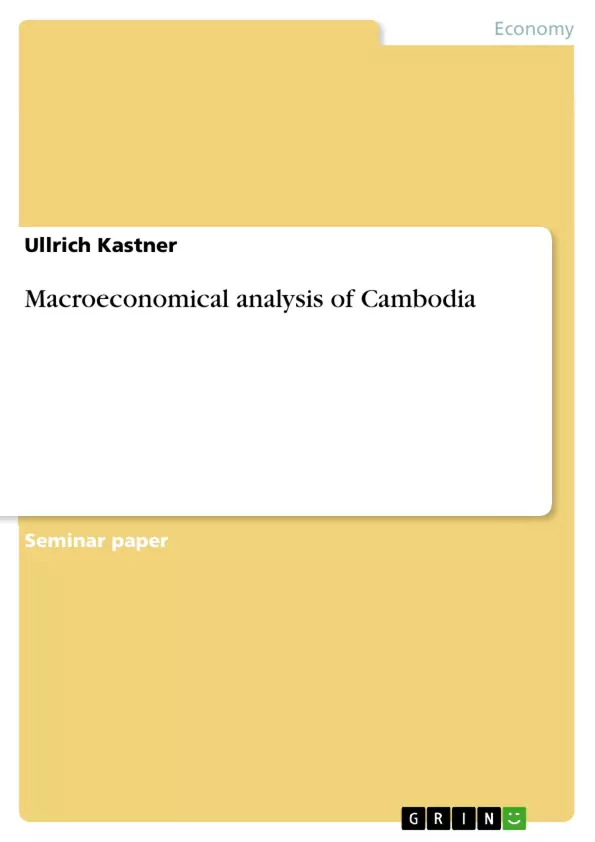For my term paper fall 2001 I chose the Kingdom of Cambodia. I travelled South East Asia in 1995 and 1997, saw all the major attractions and countries of the area, but Cambodia struck me most. Its fantastic nature, friendly people and archaeological sites overwhelmed me. Cambodia lies in South East Asia and is surrounded by three countries: Thailand in the west, Vietnam in the east and Laos in the north. In the south its coastline runs along the Gulf of Thailand. Its land area is 181,035 sq km and approximately 12,1 million people live there.
As Cambodia is now about to recover from around 30 years of civil war and anarchy, many reasons of the nowadays problems can be found in the historical events. The "Killing Fields" are still in everybody′s mind as a symbol for a cruel genocide that took place under the rule of the Khmer Rouge. But Cambodia is also famous for its archaeological places, like "Ankor Wat", the biggest temple side of the world. To explain and analyse the actual macroeconomic situation, I want to give a brief overview over the recent history of the last 60 years first.
Inhaltsverzeichnis (Table of Contents)
- I. Introduction
- II. Cambodia, a Macro Economical Analysis
- 1. History
- 2. Background Information
- a) Demographics
- b) Political Structure
- c) Economical Situation
- 3. An Economical Analysis
- a) Performance over the last few years...
- b) Asia Crisis 1997
- c) Domestic Performance in 2000
- d) The Main Columns of the Cambodian Industry
- e) AIDS and Other Diseases and Illnesses...
- f) Education
- III. Conclusion
- 1. Finish the War Crime Tribunals
- 2. Political Environment
- 3. Economical Suggestions
Zielsetzung und Themenschwerpunkte (Objectives and Key Themes)
This term paper provides a comprehensive analysis of Cambodia's macroeconomic situation, focusing on its recent history and development after years of conflict. It delves into the country's historical background, political structure, and economic performance, offering insights into Cambodia's progress and the challenges it faces.
- Historical Overview and Impact of Conflict
- Demographic Trends and Socioeconomic Implications
- Political Landscape and Challenges to Stability
- Economic Performance and Key Development Indicators
- Cambodia's Path Towards Recovery and Development
Zusammenfassung der Kapitel (Chapter Summaries)
- I. Introduction: This chapter introduces the topic of Cambodia's macroeconomic analysis and provides a brief overview of the country's history and current situation. It highlights the impact of the Khmer Rouge regime and the ongoing challenges faced by the country.
- II. Cambodia, a Macro Economical Analysis: This chapter explores Cambodia's recent history, examining the key events that shaped the country's economic landscape. It discusses the political structure and the challenges to stability, as well as the demographic trends and socioeconomic implications. The chapter further delves into Cambodia's economic situation, analyzing performance indicators and the main economic sectors.
Schlüsselwörter (Keywords)
The key terms and focus topics of this text include Cambodia's macroeconomic situation, post-conflict development, historical analysis, political structure, economic performance, demographic trends, and development indicators. It explores themes such as the impact of the Khmer Rouge regime, challenges to stability, and Cambodia's progress towards recovery and development.
- Arbeit zitieren
- Ullrich Kastner (Autor:in), 2001, Macroeconomical analysis of Cambodia, München, GRIN Verlag, https://www.grin.com/document/13725



